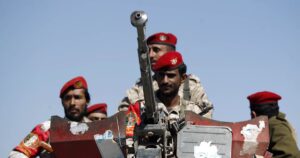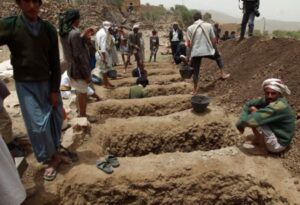The War in Yemen, a devastating proxy conflict fueled by regional rivalries, has plunged the country into the world’s worst humanitarian crisis. Along the banks of the most important waterway on Earth sits the country of Yemen—a place that was divided into two nations for decades until its unification in 1990.
A fragile patchwork of groups, each with different tribal backgrounds, religious beliefs, and political aspirations.
The story I want to tell begins in the 1990s, when a group formed in the northern mountains of Yemen. It started with a group of religious Yemenis who called themselves the Believing Youth, members of a Shiite Muslim sect known as the Zaidi.
Zaidi Muslims had once been the majority when Yemen was split in two. But in the newly unified country, they became a minority and felt neglected and discriminated against. At first, the Believing Youth focused on rebuilding Zaidi religious identity, hosting summer camps for young men and offering religious education.
But in the late 1990s, the group began to change in significant ways. A member of Yemen’s parliament resigned in protest and joined the Believing Youth. He believed Yemen’s government was corrupt and too heavily influenced by its northern neighbor, Saudi Arabia. And the War in Yemen has created the world’s worst humanitarian crisis.
Hussein al-Houthi

Hussein al-Houthi, blamed foreign influence for many of Yemen’s problems. After leaving the government, he used his wealth and family connections within the Zaidi community to take leadership of the Believing Youth. He envisioned an Islamic revolution, modeled after Iran’s, one that would expel foreign influence and restore Islamic values.
Under Al-Houthi’s influence, this once-peaceful group of young men in Yemen’s mountainous north began to transform. They started protesting Yemen’s president, Ali Abdullah Saleh. Soon, they took up arms, seized territory, and even established their own security checkpoints.
The Believing Youth no longer resembled a summer camp—they looked more like a militia, a full-blown rebellion. President Saleh, who had once supported the Believing Youth, grew increasingly worried. Then, in 2001, the entire Middle East changed forever.
After 9/11, the U.S. launched its War on Terror. They asked President Saleh for help, and he cooperated, accepting military aid and allowing American Special Forces to operate in Yemen—where the terrorist group Al-Qaeda had a presence. But the War in Yemen shows no signs of ending despite peace talks.
The War in Yemen: A Forgotten Crisis Fueled by Regional Power Struggles
Eighteen months later, the U.S. expanded its presence in the region even further by invading and occupying Iraq.
For Al-Houthi and his followers, this crossed a red line. The movement became deeply radicalized. Al-Houthi publicly criticized President Saleh for bowing to what he saw as American imperialism in Muslim lands. Many in Yemen agreed, joining the movement and swelling its ranks.
Al-Houthi adopted a violent slogan that remains on his movement’s flag to this day:
“God is great. Death to America. Death to Israel. Curse on the Jews. Victory to Islam.”
President Saleh, threatened by the growing rebellion, issued an arrest warrant for Al-Houthi and placed a bounty on his head. He cracked down brutally on their protests. Yet the War in Yemen remains largely overlooked by the international community.
In response, the Believing Youth launched an armed rebellion in northern Yemen, leading to fierce counterattacks by the Yemeni military. Shortly after the fighting began, Al-Houthi was killed in a cave in the north.
The rebels he left behind fought on with renewed conviction. The world would come to know them by the name of their fallen leader—the Houthis. A symbol of resistance against imperialism, they would later fire rockets at Israel and hijack cargo ships in the Red Sea. So the War in Yemen continues to devastate millions of civilians.
The War in Yemen Escalates as Houthis Wage Guerrilla Campaign
By 2004, the Houthis had become a full-blown rebellion, fighting Yemen’s government from their northern strongholds. They knew the terrain well and had local support, allowing them to wage a guerrilla war against the better-equipped Yemeni army—hiding in mountains, blending with civilians, and resisting fiercely.
As the conflict escalated, more tribes joined the Houthis, angered by the military’s brutality. Soon, the war went international.
The Houthis accused Saudi Arabia of allowing Yemeni troops to position along the border. In retaliation, they invaded Saudi territory, killing soldiers and taking hostages.
This pulled Saudi Arabia directly into the conflict. They responded with airstrikes and ground troops, pushing the Houthis back.
Meanwhile, Iran saw an opportunity. The Houthis were now fighting Saudi Arabia—Iran’s biggest rival. So, Tehran began secretly arming the Houthis. Saudi Arabia claimed to intercept an Iranian ship carrying weapons and military trainers headed for Yemen.
Whether Iran’s support was substantial or minimal, it was intentionally ambiguous.
As the Houthi-government conflict raged in the north, Saudi Arabia was fighting its own war against Al-Qaeda’s branch within its borders. Facing defeat, these militants fled south into Yemen, merging with the local Al-Qaeda faction to form Al-Qaeda in the Arabian Peninsula (AQAP)—one of the most dangerous and well-funded branches of the group. For the War in Yemen has dragged on for nearly a decade with no resolution.
AQAP’s goal? To establish a strict Islamic state across the region while waging holy war against foreign influence in Muslim lands.
This put them at odds with both the Yemeni government and the Houthis.
By 2011, the Arab Spring swept the Middle East. Protests erupted, toppling leaders. In Yemen, people demanded President Saleh’s resignation—exactly what the Houthis had fought for. Nor has the War in Yemen received the global attention it deserves.
But Saleh refused to step down, fueling unrest
Saudi Arabia, fearing chaos at its border, intervened. With UN backing, they convinced Saleh to transfer power to his vice president, Abdrabbuh Mansur Hadi, in exchange for immunity.
Saleh left with billions in stolen wealth—and the loyalty of key military units.
But the people weren’t satisfied. The new government remained weak, while the Houthis grew stronger, seizing more territory with Iran’s support—missiles, drones, and training.
By 2014, they marched south, capturing large areas. Former President Saleh, in a twist, allied with the Houthis against his own successor. Together, they took the capital, Sana’a, forcing Hadi to flee to Saudi Arabia.
By 2015, the Houthis controlled the capital, government weapons, and much of the north. They imposed strict religious laws, silenced dissent, and recruited child soldiers. As the War in Yemen worsens, famine and disease spread unchecked.
Saudi Arabia, alarmed, formed a coalition (with UAE, Egypt, and others) and invaded Yemen, aiming to oust the Houthis.
Crown Prince Mohammed bin Salman led the war, starting with airstrikes and a naval blockade to cut off Iranian support. While the War in Yemen rages, children suffer the most from malnutrition.
The U.S., reluctant but tied to Saudi Arabia, sold billions in weapons—including banned cluster munitions.
The war spiraled:
- Houthis (Iran-backed) vs. Saudi coalition (U.S.-armed).
- AQAP seized central territory.
- ISIS launched scattered attacks.
- U.S. airstrikes targeted terrorists.
In 2017, Saudi Arabia convinced Saleh to betray the Houthis. Days later, he was killed.
By 2019, the UAE left the coalition, instead backing southern separatists (STC). Yemen fractured further:
- Houthis (North).
- Government + Saudi coalition (East).
- STC separatists (South, UAE-backed).
- AQAP/ISIS (scattered).
A 2022 UN ceasefire brought fragile calm as Saudi-Iran talks (brokered by China) cooled tensions. But the blockade continued, deepening Yemen’s humanitarian crisis (20 million needing aid). If the War in Yemen doesn’t end soon, an entire generation will be lost.
after Hamas’ attack on Israel in 2023
the Houthis joined Iran’s “axis of resistance,” firing missiles at Israel and attacking Red Sea ships, disrupting 25% of global trade.
The U.S. and UK struck back, bombing Houthi targets—dragging themselves deeper into Yemen’s war.
Why This Matters
Yemen’s conflict is a proxy war—a cycle where geopolitical rivals (Saudi Arabia vs. Iran) exploit local struggles for power. They fuel violence, creating power vacuums filled by extremists (AQAP, ISIS).
The result? Destroyed cities, shifted borders, and immense human suffering—all while powerful nations scramble for influence. Although the War in Yemen is complex, the world must not ignore it.
you can read more about The War in Yemen here and also watch more about The War in Yemen here:


